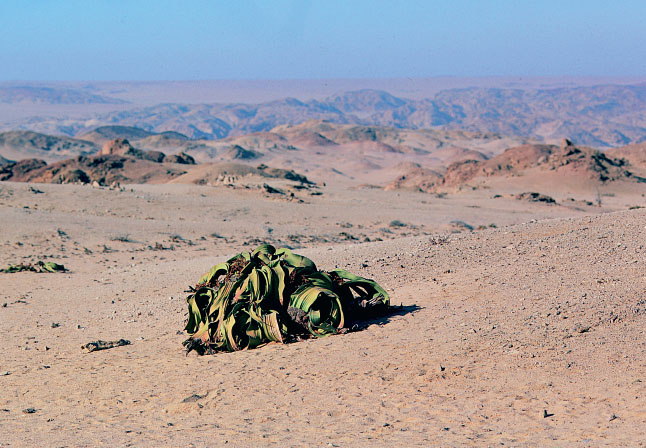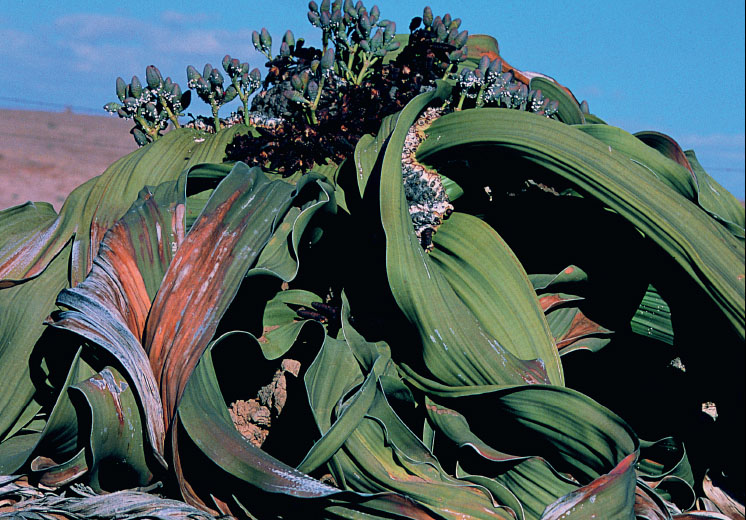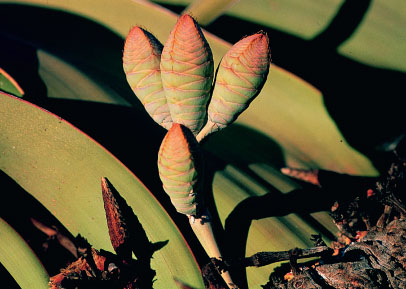
BOTANICAL NAME
Welwitschia mirabilis
DISTRIBUTION
The northern gravel plains of the Namib Desert, from the Kuiseb River to southern Angola.
OLDEST KNOWN LIVING SPECIMEN
Carbon-dating of the largest Namibian trees indicates that they are more than 2,000 years old.
CONSERVATION STATUS
Not classified on the IUCN Red List of Threatened Species.

The extraordinary welwitschia growing in the desert near Swakopmund in Namibia.
Of all the strange and wonderful ancient trees around the world, the welwitschia is perhaps the species that looks most like an extra-terrestrial form of life. Half-buried in the sands of the lunar landscape of the Namib Desert, it is unlike any other tree. The first European to discover it (in 1859), after whom it is named, was the Austrian-born doctor and botanist Friedrich Welwitsch (1807–72). So bizarre did the plant seem, he was afraid to reach out and touch it, fearing that it was simply a mirage.
Welwitschia mirabilis is now known to exist only on the gravel plains of the northern Namib Desert, from the Kuiseb River to southern Angola. In some areas, such as Swakopmund, welwitschias exist in large numbers and form the dominant vegetation. The ancestry of the welwitschia is thought to be extremely ancient and it is regarded as a ‘living fossil’ – a link with the prehistoric flora of the super-continent Gondwana, which existed millions of years ago. The form and proportions of the welwitschia are so unusual that there is nothing else comparable in the plant kingdom. It is so unlike any other plant that it is a unique species, occupying its own genus.
The name given to the tree by the Topnaar, who live in the western central Namib Desert, is Otji-tumbo or Mr Big. The ‘trunk’ of the welwitschia takes the form of an inverted cone, like a giant parsnip, and is almost entirely buried under the sand. It can reach a girth of 1.2m (4ft) or more and rarely rises more than 1m (3ft) above the ground, but tapers into a tap root that penetrates the desert floor by some 3m (10ft). Although primarily a water-storage organ, the trunk is reported to be as hard as the hardest wood and covered in a corrugated, cork-like bark.

The Welwitschia has adapted to the harsh environment of the Namib Desert, which receives less than 3cm (1¼in) of rain each year.
From the subterranean trunk, a crown of dishevelled foliage spreads out across the arid desert surface. This typically appears as a mound of vegetation torn to tatters by the desert wind. Strangely, the adult plant bears just a single pair of leathery leaves, which emerge from deep grooves on opposite sides of the broad, squat ‘trunk’, with a pronounced crater in the centre. The leaves, which are greenish-brown in colour, can grow to a staggering 1.8m (6ft) in length in old trees, and are the only ones ever produced during its entire lifetime – which may extend to thousands of years. As the leaves develop, they become broad, leathery and heavily ribbed; over time they are torn into narrow ribbons by the fierce desert winds. These ribbons become twisted, bent and entangled and lie in tattered heaps on either side of the crown.

This ancient welwitschia is estimated to be over 1,500 years old, yet stands just 1.5m (5ft) tall.
Everything about the welwitschia is curious, including its flowering habit. Trees are either male or female – the male trees have erect scarlet cones that rise about 30cm (12in) above the trunk, and ‘flowers’ that sprout from the scales of the cones. The pollen is conveyed to the reddish cones of the female trees by insects. This is unique among conifers. Once pollinated, the females produce small winged seeds that are dispersed by the wind. These can lie dormant in the sand or in rocky crevices for many years before germinating.
The welwitschias are true survivors. Not only do they thrive in the demanding environment of the Namib Desert, but research has also shown that they can also live for thousands of years. Tests carried out on welwitschias using carbon-14 dating techniques have established the age of some of the trees. Certain larger individuals, with trunks measuring over 1m (3¼ft) at the crown, were found to be more than 2,000 years old, while even those of modest size were over 700 years old.
The very great age that the welwitschia may reach, like many other ancient tree species, may be part of its long-term survival strategy. It may be that climatic cycles are in operation in western Africa that should be measured in hundreds (if not thousands) of years. Undoubtedly, in the past, parts of Africa enjoyed far more rain than they do today, so it may be the case that the welwitschia is adapted to a cycle of climatic variation that is on too grand a scale for us to perceive.

Welwitschia is unique amongst conifers in being pollinated by insects.
Since rain is absent in the desert for three out of every four years, the welwitschia has adapted to maximize and conserve the little water that is available. Early researchers noted the long tap root and believed that it penetrated deep into the ground to draw up underground water. However, research has revealed that while the tap root is important during the four-yearly rains, the plant has developed a more ingenious way of collecting water. The welwitschia grows in a part of the Namib Desert that is subject to dense sea fogs all year round, and it is the condensation of the fog and heavy dews that provide the tree with its water. Specially adapted pores on the leaves trap the precious moisture from the air, while the tangle of torn leaves enables the water to be channelled on to the sand so that it can be absorbed by the plant’s roots.
Another of the welwitschia’s survival strategies is to make itself unpalatable to grazing animals. The leaves and bark contain bitter compounds that deter most predators, although the black rhino has been known to eat the welwitschia from time to time. The tree also exudes a colourless resin from its leaves and stem, which protects it against most insects and diseases. However, the dwarf tree’s most prominent inhabitant is the yellow and black pyrrhocorid bug (Probergrothius sexpunctatus), which has found a way round the welwitschia’s defences and lives by sucking its sap.
One curious aspect of the welwitschia’s botany is the ability of several plants living close together to fuse into larger ‘graft complexes’. The English botanist H. H. W. Pearson wrote in 1909:
‘Of three such united groups, one consisted of a solid mass of five plants – one male and four female. One of the female plants, occupying a central position, appeared as if longitudinally split from the crown downwards by the ingrowth of another. A second clump contained two females at least: they were so intimately united that details of individuals could not be made out. In a third group, the largest of the three, the number of constituent plants was quite indeterminable.’

Part of the survival strategy of the welwitschia is to collect water from the sea mists that condense on the large area of twisted and wind-shredded leaves.